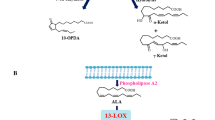Abstract
Synthesis of carotenoids in higher plants occurs in the plastids, but all of the required enzymes are coded for in the nuclear genome and are post-transcriptionally imported into the plastid compartment. Regulation of the synthesis of the enzymes is poorly understood. The two-step desaturation of phytoene to zeta-carotene, carried out by the enzyme phytoene desaturase (PDS), is one of the earliest steps in the pathway and has been studied in several systems. Previous analyses of phytoene-accumulating tissue suggested that there may be feedback regulation of PDS gene transcription, with higher expression in white tissue. To investigate this regulation further, we examined phytoene-accumulating tissue in Arabidopsis thaliana (L.) Heynh. Two types of phytoene-accumulating tissue were studied: Norflurazon-bleached plants and white sectors from the immutans variegation mutant. Based on competitive RT-PCR measurements of PDS mRNA and immunochemical detection of PDS protein, we determined that there is no significant induction of PDS gene expression specific to white tissue, indicating that PDS expression is independent of the pigment status of the cells. Reasons why our results differ from those in other systems are discussed.
Similar content being viewed by others
References
Ausubel FM, Brent R, Kingston RE, Moore DD, Seidman JG, Smith JA, Struhl K: Current Protocols in Molecular Biology. Greene Publishing Associates/Wiley Intersience, New York (1987; updated supplements).
Bartley GE, Scolnik PA: Plant carotenoids: pigments for photoprotection, visual attraction, and human health. Plant Cell 7: 1027–1038 (1995).
Bartley GE, Viitanen PV, Pecker I, Chamovitz D, Hirschberg J: Molecular cloning and expression in photosynthetic bacteria of a soybean cDNA coding for phytoene desaturase, an enzyme of the carotenoid biosynthesis pathway. Proc Natl Acad Sci USA 88: 6532–6536 (1991).
Beckler GS: Production of milligram amounts of highly translatable RNA using the RiboMAX system. Promega Notes 39: 12–16 (1992).
Blume DE, McClure J: Developmental effects of Sandoz 6707 on activities of enzymes of phenolic and general metabolism in barley shoots grown in the dark or under low or high intensity light. Plant Physiol 65: 238–244 (1980).
Böger P, Sandmann G: Modern herbicides affecting typical plant processes. In: Haug G, Hoffmann H (eds) Controlled Release, Biochemical Effects of Pesticides, Inhibition of Plant Pathogenic Fungi, pp. 173–216. Springer-Verlag, Berlin (1990).
Bonk M, Tadros M, Vandekerckhove J, Al-Babili S, Beyer P: Purification and characterization of chaperonin 60 and heatshock protein 70 from chromoplasts of Narcissus pseudonarcissus. Plant Physiol 111: 931–939 (1996).
Chamovitz D, Sandmann G, Hirschberg J: Molecular and biochemical characterization of herbicide-resistant mutants of cyanobacteria reveals that phytoene desaturation is a ratelimiting step in carotenoid biosynthesis. J Biol Chem 268: 17348–17353 (1993).
Corona V, Aracri B, Kosturkova G, Bartley GE, Pitto L, Giorgetti L, Scolnik PA, Giuliano G: Regulation of a carotenoid biosynthesis gene promoter during plant development. Plant J 9: 505–512 (1996).
Demmig-Adams B, Gilmore AM, Adams WW III: In vivo functions of carotenoids in higher plants. FASEB J 10: 403–412 (1996).
Gilliland G, Perrin S, Bunn HF: Competitive PCR for quantitation of mRNA. In: Innis MA, Gelfand DH, Sninsky JJ, White TJ (eds), PCR Protocols: A Guide to Methods and Applications, pp. 60–69. Academic Press, San Diego (1990).
Giuliano G, Bartley GE, Scolnik PA: Regulation of carotenoid biosynthesis during tomato development. Plant Cell 5: 379–387 (1993).
Horton P, Ruban AV, Walters RG: Regulation of light harvesting in green plants. Plant Physiol 106: 415–420 (1994).
Linden H, Lucas MM, de Felipe MR, Sandmann G: Immunogold localization of phytoene desaturase in higher plant chloroplasts. Physiol Plant 88: 229–236 (1993).
Mayfield SP, Nelson T, Taylor WC, Malkin R: Carotenoid synthesis and pleiotropic effects in carotenoid-deficient seedlings of maize. Planta 169: 23–32 (1986).
Meehan L, Harkins K, Chory J, Rodermel S: Lhcb transcription is coordinated with cell size and chlorophyll accumulation: Studies on fluorescence-activated, cell-sorterpurified single cells from wild-type and immutans Arabidopsis thaliana. Plant Physiol 112: 953–963 (1996).
Norris SR, Barrette TR, Della-Penna D: Genetic dissection of carotenoid synthesis in Arabidopsis defines plastoquinone as an essential component of phytoene desaturation. Plant Cell 7: 2139–2149 (1995).
Oelmüller R: Photooxidative destruction of chloroplasts and its effect on nuclear gene expression and extraplastidic enzyme levels. Photochem Photobiol 49: 229–239 (1989).
Reiss T, Bergfeld R, Link G, Thien W, Mohr H: Photooxidative destruction of chloroplasts and its consequences for cytosolic enzyme levels and plant development. Planta 159: 518–528 (1983).
Schmidt A, Sandmann G, Armstrong GA, Hearst JE, Böger P: Immunological detection of phytoene desaturase in algae and higher plants using an antiserum raised against a bacterial fusion-gene construct. Eur J Biochem 184: 375–378 (1989).
Schulz A, Ort O, Beyer P, Kleinig H: SC-0051, a 2-benzoylcyclohexane-1,3-dione bleaching herbicide, is a potent inhibitor of the enzyme p-hydroxyphenylpyruvate dioxygenase. FEBS Lett 318: 162–166 (1993).
Scolnik PA, Bartley GE: Phytoene desaturase from Arabidopsis. Plant Physiol 103: 1475 (1993).
Seibert PD: Quantitative PCR. Methods and Applications Book 3, Clonetech Laboratories, Palo Alto, CA (1993).
Souazé F, Ntodou-Thomé A, Tran CY, Rostène W, Forgez P: Quantitative RT-PCR: limits and accuracy. BioTechniques 21: 280–285 (1996).
Sundqvist C, Ryberg M: Pigment-Protein Complexes in Plastids: Synthesis and Assembly. Academic Press, San Diego, CA (1993).
Susek RE, Ausubel FM, Chory J: Signal transduction mutants of Arabidopsis uncouple nuclear CAB and RBCS gene expression from chloroplast development. Cell 74: 787–799 (1993).
Wetzel CM, Jiang C-Z, Meehan LJ, Voytas DF, Rodermel SR: Nuclear-organelle interactions: the immutans variegation mutant of Arabidopsis is plastid autonomous and impaired in carotenoid biosynthesis. Plant J 6: 161–175 (1994).
Author information
Authors and Affiliations
Rights and permissions
About this article
Cite this article
Wetzel, C.M., Rodermel, S.R. Regulation of phytoene desaturase expression is independent of leaf pigment content in Arabidopsis thaliana. Plant Mol Biol 37, 1045–1053 (1998). https://doi.org/10.1023/A:1006021522259
Issue Date:
DOI: https://doi.org/10.1023/A:1006021522259




